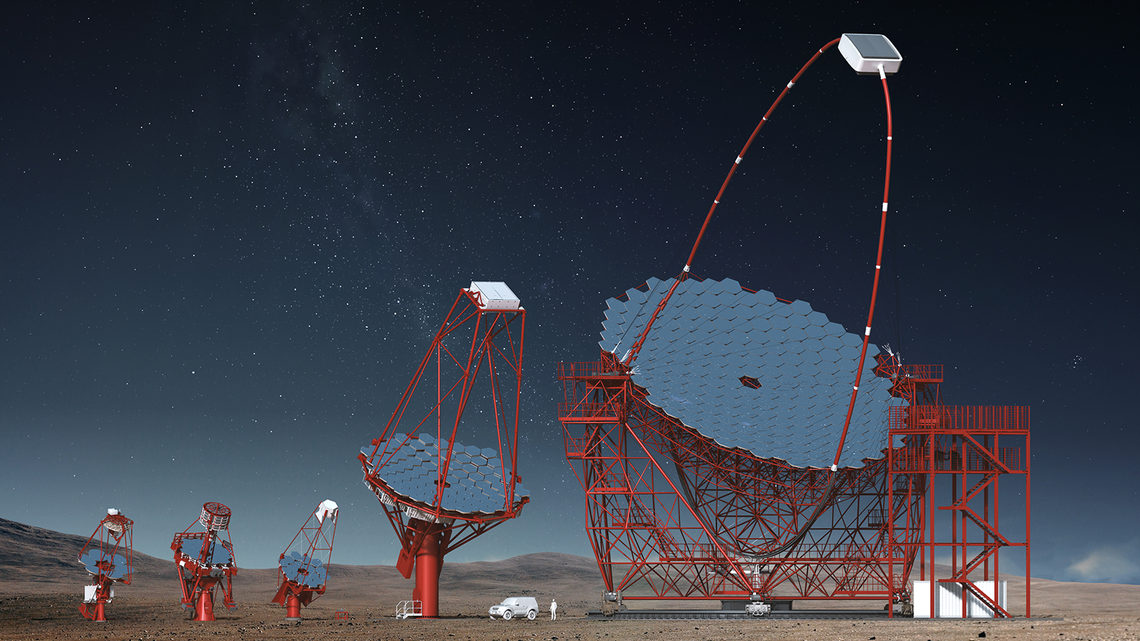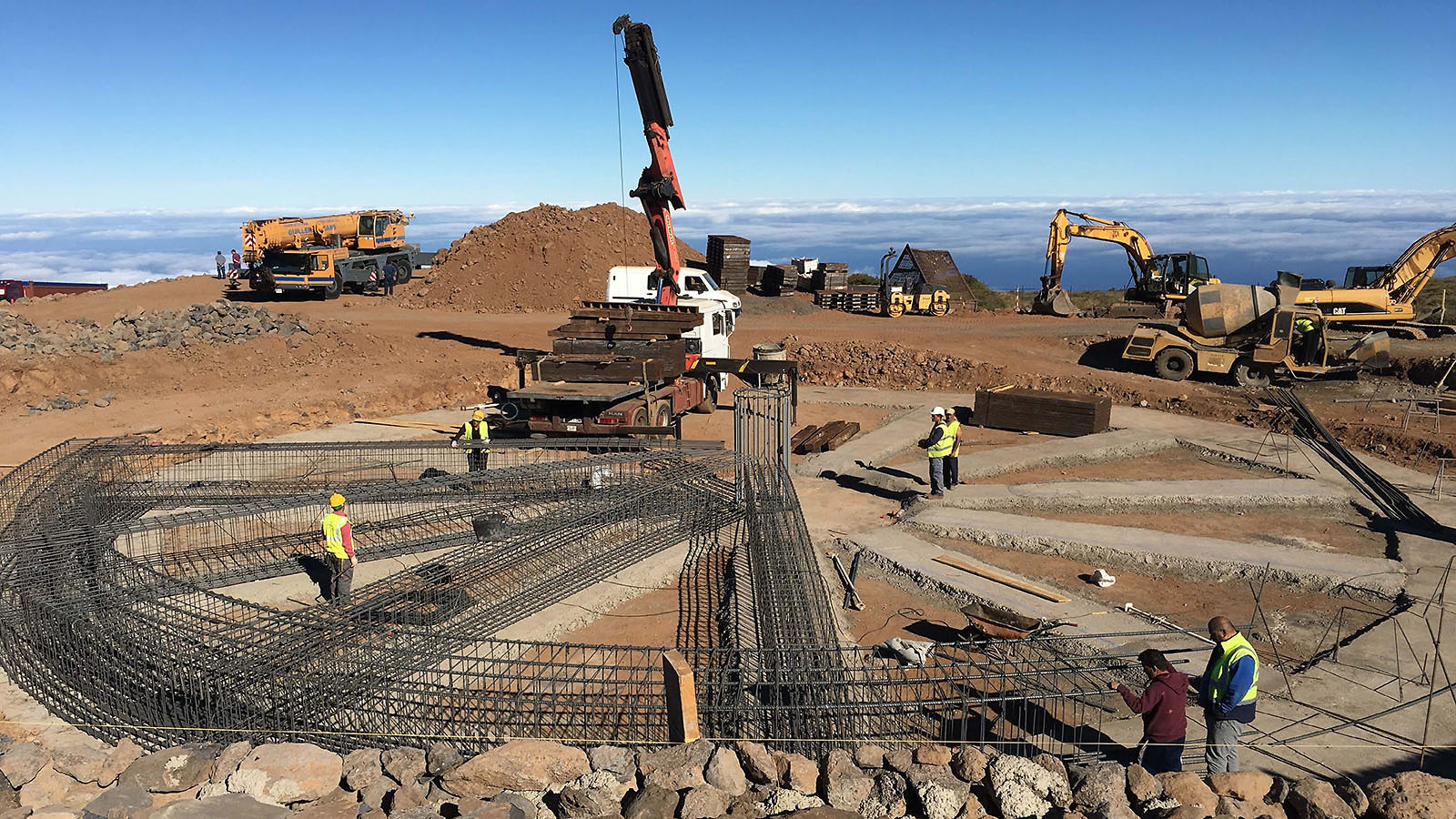Billions of light-years away, a supermassive black hole is spewing high-energy radiation, launching it far outside of the confines of its galaxy. Some of the gamma rays released by that turbulent neighborhood travel unimpeded across the universe, untouched by the magnetic fields threading the cosmos, toward our small, rocky, blue planet.
We have space-based devices, such as the Fermi Gamma-ray Space Telescope, that can detect those messengers, allowing us to see into the black hole’s extreme environment or search for evidence of dark matter. But Earth’s atmosphere blocks gamma rays. When they meet the atmosphere, sequences of interactions with gas molecules break them into a shower of fast-moving secondary particles. Some of those generated particles—which could be, for example, fast-moving electrons and their antiparticles, positrons—speed through the atmosphere so quickly that they generate a faint flash of blue light, called Cherenkov radiation.
A special type of telescope—large mirrors fitted with small reflective cones to funnel the faint light—can detect this blue flash in the atmosphere. Three observatories equipped with Cherenkov telescopes look at the sky during moonless hours of the night: VERITAS in Arizona has an array of four; MAGIC in La Palma, Spain, has two; and HESS in Namibia, Africa, has an array of five. All three observatories have operated for at least 10 years, revealing a gamma-ray sky to astrophysicists.
“Those telescopes really have helped to open the window, if you like, on this particular region of the electromagnetic spectrum,” says Paula Chadwick, a gamma-ray astronomer at Durham University in the United Kingdom. But that new window has also hinted at how much more there is to learn.
“It became pretty clear that what we needed was a much bigger instrument to give us much better sensitivity,” she says. And so gamma-ray scientists have been working since 2005 to develop the next-generation Cherenkov observatory: “a discovery machine,” as Stefan Funk of Germany’s Erlangen Centre for Astroparticle Physics calls it, that will reveal the highest energy objects and events across the entire sky. This is the Cherenkov Telescope Array (CTA), and construction has begun.
Ironing out the details
As of now, nearly 1400 researchers and engineers from 32 countries are members of the CTA collaboration, and membership continues to grow. “If we look at the number of CTA members as a function of time, it’s essentially a linear increase,” says CTA spokesperson Werner Hofmann.
Technology is being developed in laboratories spread across the globe: in Germany, Italy, the United Kingdom, Japan, the United States (supported by the NSF—given the primarily astrophysics science mission of the CTA, it is not a part of the Department of Energy High Energy Physics program), and others. Those nearly 1400 researchers are collaborating and working together to gain a better understanding of how our universe works. “It’s the science that’s got everybody together, got everybody excited, and devoting so much of their time and energy to this,” Chadwick says.

The CTA will be split between two locations, with one array in the Northern Hemisphere and a larger one in the Southern Hemisphere. The dual location enables a view of the entire sky.
CTA’s northern site will host four large telescopes (23 meters wide) and 15 medium telescopes (12 meters wide). The southern site will also host four large telescopes, plus 25 medium and 70 small telescopes (4 meters) that will use three different designs. The small telescopes are equipped to capture the highest energy gamma rays, which emanate, for example, from the center of our galaxy. That high-energy source is visible only from the Southern Hemisphere.
In July 2015, the CTA Observatory (CTAO) council—the official governing body that acts on behalf of the observatory—chose their top locations in each hemisphere. And in 2016, the council has worked to make those preferences official. On September 19 the council and the Instituto de Astrofísica de Canarias signed an agreement stating that the Roque de los Muchachos Observatory on the Canary Island of La Palma would host the northern array and its 19 constituent telescopes. This same site hosts the current-generation Cherenkov array MAGIC.
Construction of the foundation is progressing at the La Palma site to prepare for a prototype of the large telescope. The telescope itself is expected to be complete in late 2017.
“It’s an incredibly aggressive schedule,” Hofmann says. “With a bit of luck we’ll have the first of these big telescopes operational at La Palma a year from now.”
While the large telescope prototype is being built on the La Palma site, the medium and small prototype telescopes are being built in laboratories across the globe and installed at observatories similarly scattered. The prototypes’ optical designs and camera technologies need to be tested in a variety of environments. For example, the team working on one of the small telescope designs has a prototype on the slope of Mount Etna in Sicily. There, volcanic ash sometimes batters the mirrors and attached camera, providing a test to ensure CTA telescopes and instruments can withstand the environment. Unlike optical telescopes, which sit in protective domes, Cherenkov telescopes are exposed to the open air.
The CTAO council expects to complete negotiations with the European Southern Observatory before the end of 2016 to finalize plans for the southern array. The current plan is to build 99 telescopes in Chile.
This year, the council also chose the location of the CTA Science Management Center, which will be the central point of data processing, software updates and science coordination. This building, which will be located at Deutsches Elektronen-Synchrotron (also known as DESY) outside of Berlin, has not yet been built, but Hofmann says that should happen in 2018.
The observatory is on track for the first trial observations (essentially, testing) in 2021 and the first regular observations beginning in 2022. How close the project’s construction stays to this outlined schedule depends on funding from nations across the globe. But if the finances remain on track, then in 2024, the full observatory should be complete, and its 118 telescopes will then look for bright flashes of Cherenkov light signaling a violent event or object in the universe.







